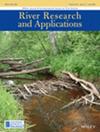恢复冷水溪流栖息地的情景规划管理行动:比较机制和统计建模方法
IF 1.9
4区 环境科学与生态学
Q4 ENVIRONMENTAL SCIENCES
引用次数: 0
摘要
根据美国《清洁水法案》,各州必须定期评估本州水域,以确定其是否符合水质标准(包括温度),然后根据需要为受损水域制定最大日负荷总量 (TMDL),以使其符合标准。我们比较了应用于三个 TMDL 流域(俄勒冈州中叉 John Day、华盛顿州风河、华盛顿州南叉 Nooksack)主干流的机理溪流温度模型(HeatSource、QUAL2K 和 QUAL2Kw)与应用于整个流域的空间溪流网络 (SSN) 模型的性能,并利用这些模型来评估修复策略的潜在效果。SSN 模型在干流预测方面的准确性(RMSE = 0.47-0.87)略低于机理模型(RMSE = 0.4),但却能为管理提供更多信息,包括整个流域修复效果的时空异质性信息。在所考虑的四种方案(将河岸带恢复为潜在的自然植被、河道变窄、通过限制灌溉取水来增加流量以及综合应用)中,河岸带恢复始终是降低出口、主干和整个流域温度的最有效方案。在流域内部和流域之间,预测的热机制恢复效果差异很大。如果只关注流域出口或干流沿岸的水质标准超标情况,就会忽略支流和上游鱼类栖息地的修复潜力、干流沿岸对维持洄游通道至关重要的热庇护区的创建潜力以及不同时空的热机制异质性。本文章由计算机程序翻译,如有差异,请以英文原文为准。
Scenario Planning Management Actions to Restore Cold Water Stream Habitat: Comparing Mechanistic and Statistical Modeling Approaches
Under the United States Clean Water Act, states are required to periodically assess state waters to determine compliance with water quality criteria (including temperature) and then to develop total maximum daily loads (TMDLs) for impaired waters as necessary to bring them into compliance. We compared the performance of mechanistic stream temperature models (HeatSource, QUAL2K, and QUAL2Kw) applied to the mainstem of three TMDL watersheds (Middle Fork John Day, OR; Wind River, WA; South Fork Nooksack, WA) with that of spatial stream network (SSN) models applied to the full watersheds and used these to evaluate the potential effectiveness of restoration strategies. SSN models performed well with slightly lesser accuracy (RMSE = 0.47–0.87) for mainstem predictions than mechanistic models (RMSE = 0.4) but provided additional benefits to inform management, including information on spatial and temporal heterogeneity of restoration effectiveness throughout the watershed. Of the four scenarios considered (restoration of riparian zones to potential natural vegetation, channel narrowing, increasing flow by restricting irrigation withdrawals, and combined applications), riparian zone restoration was consistently the most effective in reducing temperatures at the outlet, mainstem, and throughout the watersheds. Predicted restoration effectiveness for thermal regimes varied significantly both within and among watersheds. A focus on water quality criteria exceedance only at the watershed outlet or along the mainstem reach can obscure knowledge of restoration potential for fish habitat in tributaries and headwaters, potential for creation of thermal refuge areas along the mainstem critical for maintaining migration corridors, and thermal regime heterogeneity across space and time.
求助全文
通过发布文献求助,成功后即可免费获取论文全文。
去求助
来源期刊

River Research and Applications
环境科学-环境科学
CiteScore
4.60
自引率
9.10%
发文量
158
审稿时长
6 months
期刊介绍:
River Research and Applications , previously published as Regulated Rivers: Research and Management (1987-2001), is an international journal dedicated to the promotion of basic and applied scientific research on rivers. The journal publishes original scientific and technical papers on biological, ecological, geomorphological, hydrological, engineering and geographical aspects related to rivers in both the developed and developing world. Papers showing how basic studies and new science can be of use in applied problems associated with river management, regulation and restoration are encouraged as is interdisciplinary research concerned directly or indirectly with river management problems.
 求助内容:
求助内容: 应助结果提醒方式:
应助结果提醒方式:


